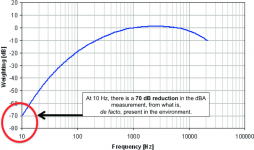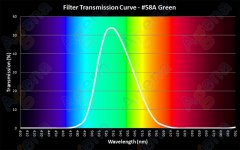Does anyone know where I can find a table to convert DbA to Db?
You would think it is on the WEB but maybe I am just not very good at surfing. I am NOT looking for an online program--I need the power/freq conversion table or curve fit for this.
(I have a power meter that only reads DbA and I need a make a curve of relative power to frequency do I need to convert DbA to dB)
Thanks!
Fritz
You would think it is on the WEB but maybe I am just not very good at surfing. I am NOT looking for an online program--I need the power/freq conversion table or curve fit for this.
(I have a power meter that only reads DbA and I need a make a curve of relative power to frequency do I need to convert DbA to dB)
Thanks!
Fritz
While the dB scale is based only on sound intensity, the dBA scale also takes into account how the human ear responds to sound intensity.
dB is independent of frequency while dBA is adjusted by a frequency weighting to account for perceived loudness.
In general you cannot convert between dB SPL and dBA measurements unless you know how the sound power is distributed with respect to frequency.
dB is independent of frequency while dBA is adjusted by a frequency weighting to account for perceived loudness.
In general you cannot convert between dB SPL and dBA measurements unless you know how the sound power is distributed with respect to frequency.
dBA is similar to lumens in photonics (e.g. the powers are weighted by human factors). I have attached my measurements of frequency vs dBA.
I was hoping for a quick generic curve fit or table to automate conversion but it appears as though the materials here (and that I have seen) don't want to publish the simple curves so i will put them in by hand and make my own fit.
Thanks!
Fritz
I was hoping for a quick generic curve fit or table to automate conversion but it appears as though the materials here (and that I have seen) don't want to publish the simple curves so i will put them in by hand and make my own fit.
Thanks!
Fritz
Attachments
Its not that easy. dBA defines a reference and a bandwidth with a specific filter. dB is not adequately specified as a level. It needs a reference and a bandwidth to have meaning. dB by itself is a ratio e.g. SNR of 100 dB. The usual reference for SPL is 20 uPa = 0 dB SPL and for example a pistonphone is calibrated thus: " The sound level produced by the pistonphone is nominally 124 ± 0.2 dB re 20 uPa" I hope this helps and doesn't further confuse.
Well-I am an optical scientist so I am templating what I know to acoustics but your post makes sense.
We are only concerned with relative power levels referenced to 1. But the bandwidth of the measurement is of course important and I assume this is buried in the "sound meter' which is a cheap on in our case.
Our final interest in all this is just to see which speakers are "flattest" and to measure the radial pattern. Not so concerned with absolute dB.
Thanks!
Fritz
We are only concerned with relative power levels referenced to 1. But the bandwidth of the measurement is of course important and I assume this is buried in the "sound meter' which is a cheap on in our case.
Our final interest in all this is just to see which speakers are "flattest" and to measure the radial pattern. Not so concerned with absolute dB.
Thanks!
Fritz
An alternative approach such as a MiniDSP Umik-1 USB mic for around $100 would be a much better fit to the stated requirements and can be used with a wide variety of software. (REW, Audio Tester, Arta, etc.) These mics have calibration files.
The dBa meter is intended for ambient noise measurements with a specific filter characteristic. (A weighting) These devices generally are not even calibrated and are of limited usefulness outside of their intended purpose.
I have a sound meter with A and C weighting and its sole purpose here is for measuring in room spls. It was calibrated at one time.
The dBa meter is intended for ambient noise measurements with a specific filter characteristic. (A weighting) These devices generally are not even calibrated and are of limited usefulness outside of their intended purpose.
I have a sound meter with A and C weighting and its sole purpose here is for measuring in room spls. It was calibrated at one time.
In optical terms: "dBA" is like metering the green light that people see so well, while plain Db SPL reads all light equally.
So is the source white light? Ruby-red laser? Near-UV "Black" light? If they were trimmed to the same total intensity, the green-loving meter would read them all differently.
If you are taking single-frequency measurements, the inverse of the dBA curve is your correction curve. Just as you meter is surely a wide-band meter with a dBA filter permanently in the chain. The dBA curve is easy to find on the www. But if your source is bassy you need a LOT of correction. Reading to 20Hz is folly because the 50dB (1/1000 pressure, 1/1,000,000 power) puts any practical source down in universal random hiss/snow.
So is the source white light? Ruby-red laser? Near-UV "Black" light? If they were trimmed to the same total intensity, the green-loving meter would read them all differently.
If you are taking single-frequency measurements, the inverse of the dBA curve is your correction curve. Just as you meter is surely a wide-band meter with a dBA filter permanently in the chain. The dBA curve is easy to find on the www. But if your source is bassy you need a LOT of correction. Reading to 20Hz is folly because the 50dB (1/1000 pressure, 1/1,000,000 power) puts any practical source down in universal random hiss/snow.
Attachments
I'm not sure what you mean, Wik.
An increase of 6 dB is a doubling of voltage or sound pressure level (SPL).
Perhaps you're looking for a dB to voltage difference calculator? https://www.redcrab-software.com/en/calculator/electrics/decibel-voltage-power
If not, please supply more information on what you are trying to do.
An increase of 6 dB is a doubling of voltage or sound pressure level (SPL).
Perhaps you're looking for a dB to voltage difference calculator? https://www.redcrab-software.com/en/calculator/electrics/decibel-voltage-power
If not, please supply more information on what you are trying to do.
dB is a ratio and NOT a measurement. dBSPL is a measurement because it is relative to the reference level Zero dBA, p0 = 20 μPa, that's a sound pressure of 20 micro-Pascals.
https://en.wikipedia.org/wiki/Sound_pressure
https://en.wikipedia.org/wiki/Sound_pressure
Last edited:
Actually dB(A) SPL vs dB SPL.
If one has some knowledge of the original measurement it should be possible to convert from dB(A) SPL to dB SPL by taking the response of the A-weighing filter into account. For white noise the difference between dB(A) SPL and dB SPL is a few dB. But for most other distributions it's not so simple.
Tom
If one has some knowledge of the original measurement it should be possible to convert from dB(A) SPL to dB SPL by taking the response of the A-weighing filter into account. For white noise the difference between dB(A) SPL and dB SPL is a few dB. But for most other distributions it's not so simple.
Tom
- Home
- Design & Build
- Equipment & Tools
- Convert DbA to Db

